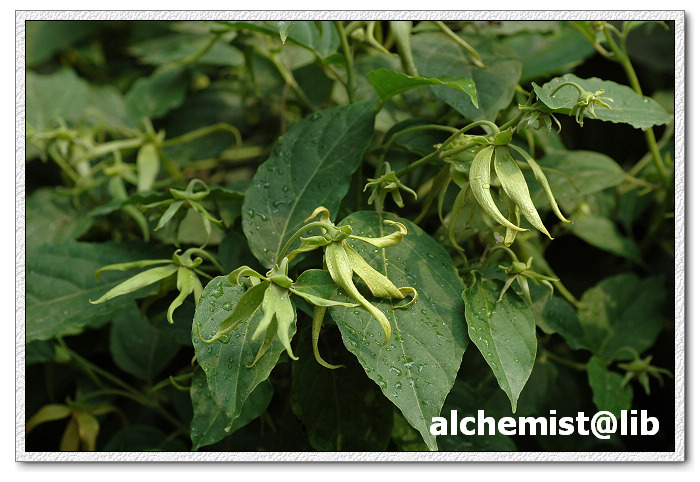- Scientific Name: Cananga odorata (Lam.) Hook.f. & Thomson
- Ref: Fl. Ind. 1:130. 1855
- Synonyms: Cananga scortechinii King; Canangium mitrastigma (F.Muell.) Domin; C. odoratum (Lam.) Baill. ex King; C. scortechinii King; Fitzgeraldia mitrastigma F.Muell.; Unona cananga Spreng.; U. leptopetala DC.; U. odorata (Lam.) Dunal; U. ossea Blanco; Uvaria axillaris Roxb.; U. odorata Lam.; U. ossea (Blanco) Blanco; U. trifoliata Gaertn.; U. undulata Lam.
- English Common Name: cananga tree, ylang-ylang
- Chinese Common Name: 依兰 yīlán, 依兰香 yīlán∙xiāng
- Japanese Common Name: イランイランノキ[イランイランの木] iranirannoki
- Family: Annonaceae
- Genus: Cananga
- Distribution: Cultivated. Fujian, Guangdong, Guangxi, Hainan, Sichuan, Taiwan, Yunnan [native to NE Australia, India, Indonesia, Laos, Malaysia, Myanmar, Philippines, and Thailand].
- Photo: 06/21/2009, South China Botanical Garden, Guangdong
Trees or shrubs. Bark pale gray. Branchlets dark colored, striate with age, minutely pubescent when young, glabrescent. Petiole 1-2 cm, narrowly grooved; leaf blade in 2 ranks, ovate, oblong, or broadly elliptic, 9-23 × 4-14 cm, membranous to thinly papery, often drying black, glabrous when mature except for mostly whitish pubescence along midvein and secondary veins, secondary veins 7-15 on each side of midvein, base rounded, obtuse, or truncate and often inequilateral, apex acute to acuminate. Inflorescences axillary or on short woody branches, racemose or cymose, 1- or several flowered; peduncle 2-5 mm; bracts minute, deciduous. Flowers pendulous. Pedicel 1-5 cm, pubescent, bracteolate. Sepals ovate, ca. 0.7 mm, pubescent, connate at base, apex acute and reflexed. Petals green, turning yellow and inside basally with a purplish brown blotch, linear to linear-lanceolate, 5-8 × 0.5-1.8 cm, tomentose and with several veins minutely pubescent, basal claw small. Stamens oblong-oblanceolate, 0.7-1 mm; connectives apically acute, pubescent. Carpels 10-12, ca. 4 mm, puberulent when young, glabrescent; stigmas clavate, lamellate, fused, with a U-shaped groove on inner side running down to base of ovary to form a convex pileate disk. Monocarp stipes 1.2-1.8 cm; monocarps nearly black, ovoid, globose, or oblong, 1.5-2.3 × ca. 1 cm, pulpy, glabrous. Seeds 2-12 per monocarp, pale brown, in 2 series, surface pitted. Fl. Apr-Aug, fr. Oct-Mar. (Flora of China)
